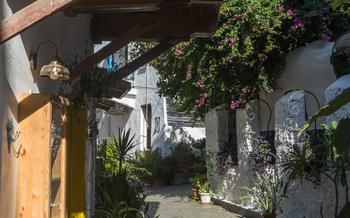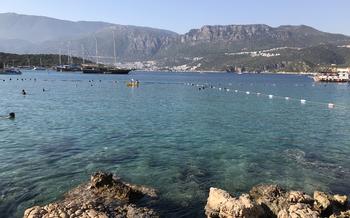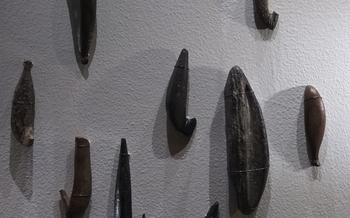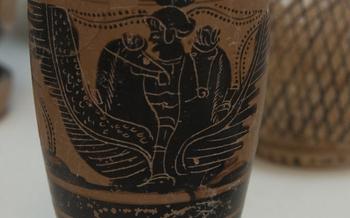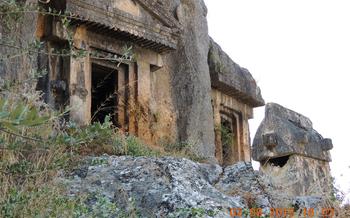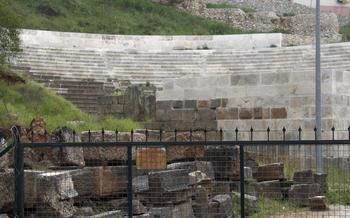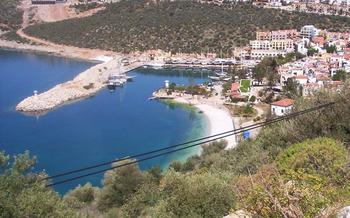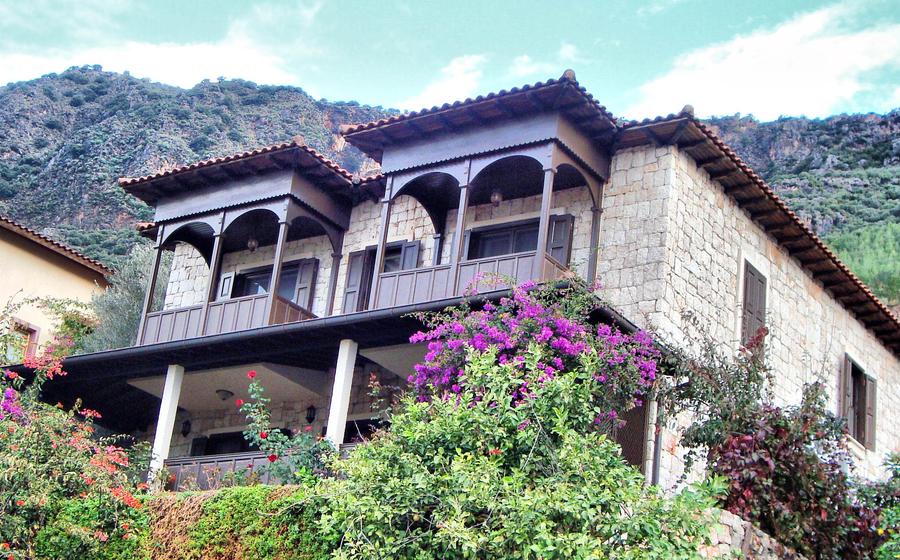
Andriake Ancient City
- Kaş: A Hidden Gem in Turkey
- Unveiling Andriake Ancient City: A Journey Through Time
- Exploring the Ruins of Andriake: A Glimpse into the Past
- The Lycian Connection: A Legacy of Ancient Civilizations
- Andriake's Enduring Heritage: A Tale of Resilience
- A Walk Through History: Exploring Andriake's Streets and Buildings
- Andriake's Fortified Walls: A Symbol of Strength and Protection
- Andriake's Necropolis: A Place of Remembrance and Honor
- Andriake's Theater: A Stage for Entertainment and Community
- Andriake's Aqueduct: An Engineering Marvel of the Ancient World
- Andriake's Agora: A Hub of Trade and Social Interaction
- Andriake's Temples: A Connection to the Divine
- Andriake's Mosaics: A Testament to Artistic Skill and Craftsmanship
- Insider Tip: Discovering Hidden Gems in Andriake
Kaş: A Hidden Gem in Turkey
In the heart of Turkey's Mediterranean coast, nestled between azure waters and verdant mountains, lies the charming town of Kaş. This unassuming gem boasts a rich history that dates back to ancient times, as evidenced by its numerous archaeological wonders and cultural treasures.
Kaş's strategic location on the Lycian Way, an ancient trade route that connected the East and West, made it a melting pot of cultures and civilizations. Over the centuries, Kaş has been ruled by various empires, including the Lycians, Romans, Byzantines, and Ottomans, each leaving their unique imprint on the town's architectural landscape and cultural heritage.
Today, Kaş is a vibrant and cosmopolitan town that seamlessly blends its ancient past with modern amenities. Visitors can explore its narrow cobbled streets, lined with traditional Ottoman houses, and admire the stunning views of the turquoise sea from its picturesque harbor. Kaş is also a popular destination for outdoor enthusiasts, offering a plethora of activities such as diving, snorkeling, sailing, and hiking.
Among the must-see attractions in Kaş is the ancient city of Andriake, a hidden gem that offers a glimpse into the town's rich history and cultural heritage. Located just a short walk from the town center, Andriake is an archaeological treasure trove that awaits exploration.
Unveiling Andriake Ancient City: A Journey Through Time
Andriake, an ancient city nestled along the picturesque shores of Kaş, holds a significant place in the annals of history. Founded in the 4th century BC, it served as a prominent member of the Lycian League, a powerful confederation of cities that flourished in ancient Anatolia. Andriake's strategic location at the crossroads of land and sea routes made it a thriving center of trade and commerce, attracting merchants and travelers from far and wide.
The allure of Andriake lies not only in its historical significance but also in its remarkably preserved ruins. Visitors can embark on a journey through time as they explore the ancient city's well-preserved streets, temples, and fortifications. Archaeological excavations conducted over the years have unearthed a wealth of artifacts, providing valuable insights into the daily lives and customs of Andriake's inhabitants.
Reaching Andriake is a breeze, as it is conveniently situated just a short distance from Kaş. Visitors can opt for a leisurely walk along the scenic coastal path or take advantage of the frequent boat tours that depart from Kaş harbor. Once in Andriake, the ancient city unfolds its secrets, inviting visitors to delve into its rich past and uncover the stories that lie beneath the surface.
Exploring the Ruins of Andriake: A Glimpse into the Past
Strolling among the ruins of Andriake is like embarking on a journey through time, where history whispers secrets and ancient stones tell tales of a bygone era. Notable structures within the city include the well-preserved theater, once a vibrant hub of entertainment, and the imposing city walls, a testament to Andriake's resilience and strategic importance.
The architectural styles and influences visible in Andriake's ruins are a testament to the city's rich cultural heritage. Hellenistic, Roman, and Byzantine influences blend harmoniously, showcasing the diverse influences that shaped Andriake's identity. Preserved artifacts and inscriptions offer glimpses into the lives and customs of the city's inhabitants, providing valuable insights into their daily routines, beliefs, and social structures.
As you explore the ruins, let your imagination transport you back in time. Picture the bustling streets filled with merchants, traders, and shoppers, the sounds of laughter and conversation echoing through the agora. Imagine the city's inhabitants gathering in the theater to witness captivating performances, or seeking solace and guidance within the sacred temples. Andriake's ruins offer a unique opportunity to connect with the past and gain a deeper understanding of the ancient world.
The Lycian Connection: A Legacy of Ancient Civilizations
Andriake was an integral part of the Lycian League, a powerful confederation of ancient cities that flourished in the region of Lycia during the 5th and 4th centuries BC. The Lycians were a seafaring people who established a vast maritime empire, trading with civilizations across the Mediterranean. Andriake's strategic location made it a crucial port city within the league, facilitating trade and cultural exchange.
The city's architecture, language, and customs bore strong influences from other ancient cultures, reflecting the cosmopolitan nature of the Lycian League. Andriake's coins featured bilingual inscriptions in both Lycian and Greek, highlighting the city's dual cultural identity. Lycian mythology and religious beliefs were deeply intertwined with those of other Mediterranean civilizations, such as the Greeks and Romans.
The Lycians left an enduring legacy in the region, including impressive architectural ruins, intricate inscriptions, and a rich mythology. Their influence can still be seen in modern-day Turkey, where Lycian motifs and symbols are incorporated into contemporary art and design. Exploring Andriake offers a glimpse into this fascinating ancient civilization, providing a tangible connection to the past.
Andriake's Enduring Heritage: A Tale of Resilience
Despite the decline of the Lycian League and subsequent invasions, Andriake managed to endure and retain its significance for centuries. Its strategic location and fortified walls played a crucial role in its resilience. The city withstood attacks by pirates and foreign powers, serving as a refuge for the local population.
Natural disasters also tested Andriake's resilience. Earthquakes and floods damaged the city, but its inhabitants rebuilt and repaired, demonstrating their determination to preserve their home. The city's water management system, including the aqueduct and cisterns, ensured a reliable water supply, vital for survival during times of drought or siege.
In the Byzantine period, Andriake became a Christian center, with several churches built within the city walls. This transformation reflects the city's ability to adapt and evolve, embracing new religious and cultural influences while retaining its unique identity.
Today, Andriake's ruins stand as a testament to its enduring heritage. Archaeological excavations continue to uncover new insights into the city's past, revealing the remarkable resilience and adaptability of its ancient inhabitants.
A Walk Through History: Exploring Andriake's Streets and Buildings
Andriake's urban layout reflects a sophisticated and well-organized society. The city's main thoroughfares, lined with shops and public buildings, intersect at right angles, creating a grid-like pattern. At the heart of the city lies the agora, a bustling marketplace and social hub where citizens gathered to trade goods, exchange news, and conduct business.
Public spaces, such as temples, theaters, and baths, were strategically placed throughout the city to cater to the needs of the population. Temples dedicated to various deities, including Apollo, Zeus, and Athena, served as religious and spiritual centers. The theater, with its well-preserved stage and seating rows, hosted theatrical performances, musical concerts, and other forms of entertainment. Baths, with their hot and cold pools, provided a place for relaxation and hygiene.
Residential areas, consisting of private dwellings, occupied the outskirts of the city. These homes, ranging from modest abodes to grand villas, reveal the diverse social strata of Andriake's society. The well-preserved remains of these structures, including intricate mosaics and frescoes, offer a glimpse into the daily lives of Andriake's inhabitants.
Exploring the streets and buildings of Andriake is like taking a journey through time, where the echoes of ancient voices and the footsteps of history still linger. Every stone, every inscription, and every architectural detail tells a story of a once-thriving city that played a significant role in the history of the Lycian League.
Andriake's Fortified Walls: A Symbol of Strength and Protection
Andriake's fortified walls stand as a testament to the city's resilience and strategic importance. Constructed using massive blocks of stone, the walls formed an imposing barrier around the city, protecting it from enemies and invaders. The walls were reinforced with towers and gates, providing additional defense and control over access to the city.
The architectural features of the walls reveal the skill and ingenuity of Andriake's builders. The walls were constructed using a combination of techniques, including dry stone construction and the use of mortar. The stones were carefully fitted together, creating a sturdy and durable structure. The walls were also sloped, which helped to deflect enemy projectiles and protect the city from attack.
The strategic importance of the walls is evident from their location. Andriake was situated on a hilltop, providing a natural advantage for defense. The walls further enhanced this advantage by creating a formidable barrier that would have been difficult for enemies to overcome. The walls also protected the city from attack by sea, as they extended down to the harbor, preventing enemy ships from entering.
The walls of Andriake are a symbol of the city's strength and resilience. They withstood numerous attacks and invasions throughout history, protecting the city and its inhabitants. Today, the walls stand as a reminder of Andriake's rich and storied past, a testament to the ingenuity and determination of its people.
Andriake's Necropolis: A Place of Remembrance and Honor
To the east of Andriake, beyond the city walls, lies the ancient necropolis, a poignant reminder of the city's rich history and the lives of its inhabitants. Here, amidst a tranquil landscape, the tombs and mausoleums of Andriake's departed stand as silent witnesses to the passage of time.
The necropolis encompasses a diverse range of burial structures, reflecting the social hierarchy and cultural practices of ancient Andriake. From simple rock-cut tombs to elaborate family mausoleums, each burial site offers a glimpse into the lives and beliefs of those laid to rest within.
Epitaphs and inscriptions etched into the tombstones reveal personal stories of love, loss, and remembrance. These inscriptions provide valuable insights into the lives of Andriake's citizens, their hopes, dreams, and fears. They speak of brave warriors, devoted mothers, and skilled artisans, each contributing to the fabric of Andriake's society.
The necropolis serves as a tangible link to the past, reminding visitors of the mortality that unites all people, regardless of their time or place. It is a place of quiet contemplation and reflection, where one can pay homage to the lives of those who came before us and appreciate the enduring legacy of Andriake.
Andriake's Theater: A Stage for Entertainment and Community
Andriake's theater, nestled within the heart of the ancient city, served as a vibrant hub for entertainment and community gatherings. Constructed with remarkable precision and artistry, the theater boasted a spacious stage, tiered seating arrangements, and an impressive backdrop of the surrounding hills. The seating, meticulously crafted from stone, accommodated a diverse audience, from the city's elite to ordinary citizens, who gathered to witness a variety of performances.
Actors, musicians, and dancers graced the stage, captivating audiences with their skills and artistry. The repertoire included comedies, tragedies, and dramas, drawing inspiration from Greek mythology, history, and everyday life. The theater's acoustics, carefully engineered to amplify the performers' voices, ensured that every word and nuance reached the farthest corners of the auditorium.
Beyond its role as a venue for entertainment, the theater played a significant social and cultural role in Andriake. It served as a gathering place where citizens from all walks of life could come together, share experiences, and foster a sense of community. The theater also hosted civic events, political assemblies, and religious ceremonies, further solidifying its importance in Andriake's urban fabric.
Imagine the atmosphere during a performance, the buzz of anticipation as the audience settled into their seats, the air charged with excitement and curiosity. The stage, illuminated by flickering oil lamps, came alive with vibrant costumes, expressive gestures, and the melodious voices of the performers. The audience, fully immersed in the unfolding drama, laughed, cried, and gasped in unison, their emotions mirroring the ebb and flow of the performance.
Andriake's theater stands as a testament to the city's rich cultural heritage and its enduring love for the arts. It invites visitors to step back in time, to envision the vibrant performances that once graced its stage and to experience the communal spirit that bound the ancient inhabitants of Andriake together.
Andriake's Aqueduct: An Engineering Marvel of the Ancient World
Andriake's aqueduct stands as a testament to the ingenuity and engineering prowess of the ancient world. Constructed with remarkable precision, the aqueduct channeled water from distant springs and rivers into the heart of the city, providing a vital resource for Andriake's inhabitants.
The aqueduct's design showcased a mastery of hydraulics and gravity. Water was captured at its source and directed into a series of channels and tunnels, which followed a carefully engineered gradient. This system ensured a continuous flow of water, even over long distances and challenging terrain.
Along its course, the aqueduct featured impressive arched bridges and viaducts, demonstrating the builders' skill in overcoming obstacles and maintaining the water's momentum. These structures not only served a functional purpose but also added an aesthetic element to the landscape, showcasing the creativity and artistry of Andriake's engineers.
The aqueduct's construction required immense labor and resources, highlighting the importance that Andriake placed on water management. Access to a reliable water supply was crucial for the city's survival, enabling agriculture, sanitation, and various industrial activities.
Andriake's aqueduct aligns with other remarkable ancient aqueduct systems, such as those found in Rome or Pompeii. These marvels of engineering underscore the ingenuity and foresight of ancient civilizations in addressing the challenges of water supply and sanitation.
By studying and appreciating Andriake's aqueduct, we gain insights into the advanced engineering techniques and urban planning principles that shaped ancient societies. It serves as a reminder of the enduring legacy of these civilizations and their contributions to the development of water management systems that continue to inspire modern engineering practices.
Andriake's Agora: A Hub of Trade and Social Interaction
In the heart of Andriake, the agora served as a bustling marketplace and social hub. This vibrant square was a place where locals and visitors gathered to exchange goods, ideas, and stories. The agora was not merely a commercial center; it was also a place where people came together to socialize, catch up on the latest news, and participate in civic affairs.
The agora was strategically located at the intersection of major roads, making it easily accessible to people from all parts of the city. It was a rectangular space surrounded by a colonnade, which provided shade and protection from the elements. Within the colonnade, shops and stalls lined the streets, displaying a variety of goods, from fresh produce and spices to pottery, textiles, and jewelry.
The agora was not just a place of commerce; it was also an important center of social and cultural activity. Public meetings, festivals, and religious ceremonies were often held in the agora. It was a place where people could come together to celebrate their shared culture, discuss important issues, and make decisions that affected the entire community.
The agora was a vital part of Andriake's urban fabric, serving as a hub of economic, social, and cultural activity. Its ruins stand as a testament to the city's vibrant past and its enduring legacy.
Andriake's Temples: A Connection to the Divine
Andriake's religious beliefs and practices played a crucial role in shaping the city's identity and culture. The ancient city was home to several temples dedicated to various deities, each with its unique architectural style and significance. The most prominent temple in Andriake was dedicated to Apollo, the Greek god of music, prophecy, and healing. This grand temple featured intricate carvings, a spacious courtyard, and an impressive altar where offerings were made to the deity.
Another significant temple in Andriake was dedicated to Athena, the goddess of wisdom, war, and crafts. This temple showcased Doric columns, a well-preserved cella, and a stunning statue of Athena that once stood within its sanctum. The temple served as a place of worship, where citizens sought guidance and protection from the revered goddess.
In addition to these major temples, Andriake also had shrines dedicated to other deities, such as Zeus, Hera, and Aphrodite. These smaller shrines, though less elaborate in architecture, held great importance in the daily lives of Andriake's inhabitants. They provided spaces for personal devotion, prayer, and offerings to the gods who watched over various aspects of life.
The temples of Andriake were not merely places of worship but also served as centers of community gatherings, religious festivals, and rituals. They played a vital role in shaping the city's cultural identity, fostering a sense of unity and belonging among its citizens.
Andriake's Mosaics: A Testament to Artistic Skill and Craftsmanship
Andriake is renowned for its exquisite mosaics, which offer a glimpse into the artistic prowess and creativity of its ancient inhabitants. These intricate artworks, meticulously crafted using small colored tiles, adorn the floors and walls of various buildings throughout the city, including temples, public spaces, and private dwellings.
The mosaics showcase a diverse range of themes and motifs, drawing inspiration from mythology, nature, and everyday life. Geometric patterns, floral designs, and depictions of animals, humans, and scenes from daily life are commonly found. The vibrant colors and intricate details of the mosaics have withstood the test of time, retaining their beauty and expressiveness despite centuries of exposure to the elements.
These mosaics provide valuable insights into the cultural and artistic traditions of Andriake. They reflect the influence of various artistic styles, including Greek, Roman, and local Anatolian influences. The mosaics also shed light on the beliefs, values, and daily lives of Andriake's inhabitants, offering a tangible connection to their rich history and heritage.
Moreover, the mosaics of Andriake have significant parallels with other ancient mosaic traditions, such as those found in Pompeii, Antioch, and other Roman cities. Comparative studies of these mosaics allow researchers to trace the evolution of mosaic art and identify common themes and techniques across different cultures and regions.
By studying and preserving these remarkable mosaics, we gain a deeper understanding of Andriake's cultural heritage and its contribution to the broader tapestry of ancient art and civilization.
Insider Tip: Discovering Hidden Gems in Andriake
To fully immerse yourself in the charm of Andriake, venture beyond the main attractions and uncover its hidden gems. Explore the lesser-known ruins scattered throughout the ancient city, where you can stumble upon forgotten temples, intricate mosaics, and enigmatic inscriptions. These secluded spots offer a unique opportunity to connect with the past in a more intimate and personal way.
To avoid the summer crowds and enjoy a more tranquil experience, consider visiting Andriake during the shoulder seasons of spring or fall. The weather is still pleasant, but you'll have the chance to explore the ruins at your own pace without the hustle and bustle of peak tourist season.
For a deeper understanding of Andriake's history and culture, enlist the services of a local guide. These knowledgeable experts can provide insights into the ancient city's past, point out hidden details, and bring the stories of its inhabitants to life.
Remember to be respectful of the local customs and traditions when visiting Andriake. Dress modestly, avoid disturbing the ruins, and ask permission before taking photographs of people or religious sites. By following these simple guidelines, you'll ensure a positive and enriching experience for yourself and the local community.
